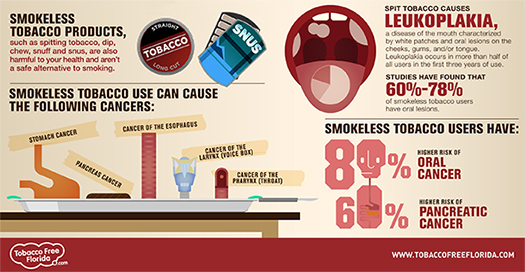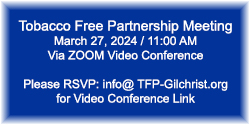News and Events
The Issue of Smokeless Tobacco
January 17, 2017
Smokeless tobacco is not burned, contains nicotine and is addictive.Smokeless tobacco is typically called spit tobacco, chewing tobacco, chew, dip, plug, and probably a few other things. Types of smokeless tobacco include:
- chewing tobacco, which comes in the form of loose leaf, plug, or twist. The most common, loose leaf, is usually packaged in foil pouches. Chewing tobacco is placed between the cheek and gums.
- snuff is finely ground tobacco that can be dry, moist, or packaged in pouches or packets. Some types of snuff are sniffed or inhaled into the nose; other types are placed in the mouth. Moist snug, the most common, is often called dip. It’s placed between the cheek or lip and gums; it requires spitting. Snus is a newer form of moist snuff used in the United States.
- dissolvables* are finely ground tobacco pressed into shapes such as tablets, sticks, or strips.3 These products slowly dissolve in the mouth. They come in the form of lozenges, orbs, sticks, and strips.
THE ISSUE
Smokeless tobacco is not safe and can lead to nicotine addiction.Many smokeless tobacco products contain cancer-causing chemicals. Smokeless tobacco can cause cancer of the mouth, esophagus, and pancreas. Smokeless tobacco can cause gum disease, tooth decay, and tooth loss. Smokeless tobacco products can also increase the risk of death from heart disease and stroke.
Many smokeless tobacco products come in flavors and packaging that appeal to young people. Candy and fruit flavors mask the bad taste of tobacco, making it easier for youth and teens to start using tobacco. With a new range of products and flavors on the market, there are more opportunities for young people to experiment with tobacco. Adolescent smokeless tobacco users are more likely than nonusers to become adult cigarette smokers.
Major U.S. cigarette companies, including R.J. Reynolds and Altria, have acquired smokeless tobacco brands. The marketing of smokeless tobacco products has also significantly increased. In 2013, tobacco companies spent more than $503 million on advertising and promotion of smokeless tobacco products– that’s more than double what was spent 10 years earlier in 2003.Much of this spending was used to pay for price cuts through coupons, sales, and giveaways.
Even without price cuts, many smokeless products cost less than conventional cigarettes, appealing both to young people and low-income communities.The difference in smokeless tobacco use among rural and non-rural populations in Florida is sizable. While only 2.4 percent of non-rural Floridian adults use smokeless tobacco, 6.3 percent of rural adults use these products – an astounding increase of 162.5 percent. This disparity is mirrored in youth use as well. While 3.1 percent of non-rural youth (ages 11-17) use smokeless tobacco, 7.4 percent of rural youth use the products (a 138.7 percent increase).
ADVOCACY
You can talk to your local officials to let them know you are concerned about the tobacco industry’s marketing tactics that target children and other vulnerable populations. Working together, you may be able to influence decision-makers to take action. You can also help encourage local venues and events to go 100% tobacco free – not just smokefree.
For information on working on this issue in your community, contact Tracy DeCubellis at TracyD@QuitDoc.com.
*Additional research is needed to examine long-term effects of newer smokeless tobacco products, such as dissolvables and U.S. snus.
World Health Organization. IARC Monographs on the Evaluation of Carcinogenic Risks to Humans. Volume 89: Smokeless Tobacco and Some Tobacco-Specific N-Nitrosamines. Lyon (France): World Health Organization, International Agency for Research on Cancer, 2007 [accessed 2016 Nov 21].
Mejia AB, Ling PM. Tobacco Industry Consumer Research on Smokeless Tobacco Users and Product Development. American Journal of Public Health 2010;100(1):78–87 [cited 2016 May 9].
U.S. Department of Health and Human Services. Preventing Tobacco Use Among Youth and Young Adults: A Report of the Surgeon General. Atlanta: U.S. Department of Health and Human Services, Centers for Disease Control and Prevention, National Center for Chronic Disease Prevention and Health Promotion, Office on Smoking and Health, 2012 [accessed 2016 Nov 21].
Cancer Prevention & Early Detection Facts and Figures 2010.
Stanfill SB, Connolly GN, Zhang L, Jia LT, Henningfield JE, Richter P, et al. Global Surveillance of Oral Tobacco Products: Total Nicotine, Unionised Nicotine and Tobacco-Specific N-Nitrosamines. Tobacco Control 2011 May;20(3):e2. doi:10.1136/tc.2010.037465 [cited 2014 Oct 31].
Piano MR, Benowitz NL, Fitzgerald GA, Corbridge S, Heath J, Hahn E, et al. Impact of Smokeless Tobacco Products on Cardiovascular Disease: Implications for Policy, Prevention, and Treatment: A Policy Statement from the American Heart Association. Circulation 2010;122(15):1520–44 [cited 2014 Oct 31].
U.S. Department of Health and Human Services. Preventing Tobacco Use Among Youth and Young Adults: A Report of the Surgeon General. Atlanta, GA: U.S. Department of Health and Human Services, Centers for Disease Control and Prevention, National Center for Chronic Disease Prevention and Health Promotion, Office on Smoking and Health, 2012.
U.S. Department of Health and Human Services. Preventing Tobacco Use Among Youth and Young Adults: A Report of the Surgeon General. Atlanta: U.S. Department of Health and Human Services, Centers for Disease Control and Prevention, National Center for Chronic Disease Prevention and Health Promotion, Office on Smoking and Health, 2012 [accessed 2016 Nov 21].
“Federal Trade Commission Smokeless Tobacco Report for 2013.” Federal Trade Commission Smokeless Tobacco Report for 2013 (2016): 2. Federal Trade Commission. 2016. Web. 15 Nov. 2016. https://www.ftc.gov/system/files/documents/reports/federal-trade-commission-smokeless-tobacco-report-2013/2013tobaccorpt.pdf.
Florida Youth Tobacco Survey (FYTS), Florida Department of Health, Bureau of Epidemiology, 2014.
Behavioral Risk Factor Surveillance System Survey Data. Atlanta, Georgia: U.S. Department of Health and Human Services, Centers for Disease Control and Prevention, 2013.





